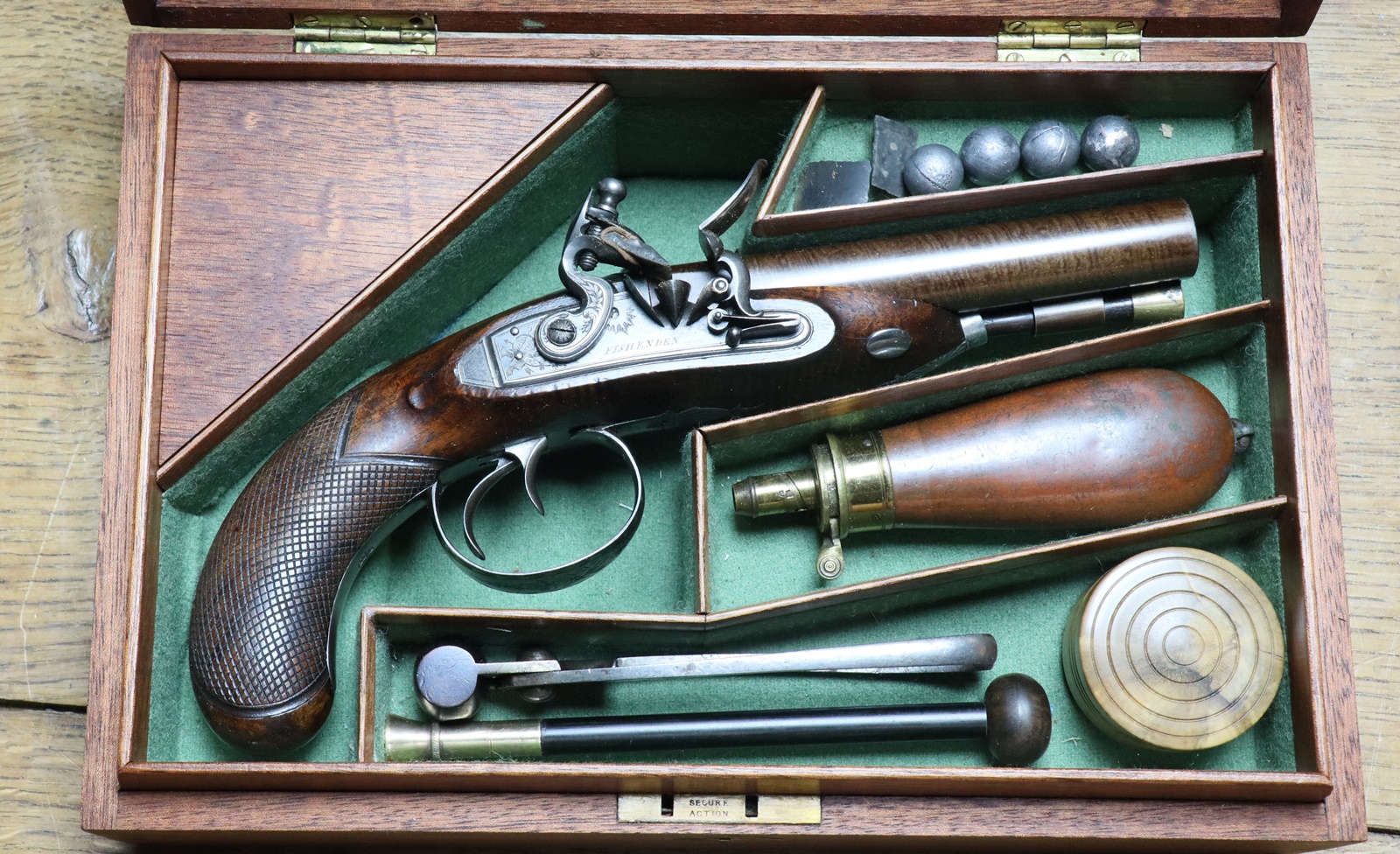Having made a case for a double barreled flintlock coaching pistol I thought I’d put post on it using bits from the diary and some additional hints and tips.
This case is unusual as its rare for a single flintlock pistol to be case – almost always flintlock pistols came in pairs – at least from about 1760 to 1850, and it wasn’t until the percussion revolver era post 1851 that single percussion revolvers pistols were commonly cased in oak boxes with brass screws visible on the top. prior to that it was usually pairs of pistols, most commonly duelling pistols in mahogany cases. _ See Keith Neil and Back’s book on Trade labels and cases.
Material;-
Oak – dark, for early cases
Mahogany – fairly fine grained , for pistols and long guns up to around 1850.
Oak – light yellow in tint – for single percussion revolvers from ?1851.
Construction;-
The carcass of almost all old cases used open dovetailed joints – the joint provided the strength as there were no good glues. These joints were cut with very fine ‘pins’ – on the outside edge of the tapered pin they were often no more than 1/16th of an inch thick – they were, of course cut by hand and they still need to be as router cutters can’t do such narrow pins – dovetail cutters for doll’s house furniture are not long enough and regular cutters have too thick a shaft. Cutting such narrow dovetails by hand requires a saw with a very thin ‘kerf’ (cut thickness) – certainly no bigger than 0.5 m.m. – I use a Japanese pull blade with a kerf of 0.3 m.m. – a fine tool for the job. The bottoms of the cuts is best done with a very fine blade in a fretsaw. We can of course use modern glues to disguise our imperfetions – but that is really cheating! Cutting fine dovetails by hand is very satisfying.
The bottoms of boxes were usually fixed in a rebate in the sides and were often of pine and quite thin. The tops were usually placed on top of the sides and held by animal glue and often panel pins. In the case of oak cases for revolvers the tops were invariably screwed in place with small brass screws.
For a pistol case the sides were usually between 10 and 12 m.m. thick, the bottom probably 5 or 6 m.m. and the top maybe 6 to 8 m.m. thick.
Lining;-
Gun cases almost always had a lining around the sides of the base that stuck up above the sides of the base by at least 12 m.m – I guess it sometimes/often reached the inside of the top of the lid. The lining strips were from about 6 to 8 m.m. thick. The outside edge was chamfered from the top of the sides and rounded on the top edge. The chamfer ensures that the lid fits snugly without rubbing as it closes. The lining could be fully covered with the lining material (baise or velvet etc) on the inside and over the top and down below the top of the sides – in which case the lining wood needs to takea ccount of the thickness of teh covering. Alternatively in better class cases the cloth ends in a sloping cut on the inside of the lining and in line with the top of the sides. The lining strips are carefully bevelled at the corners so that they fit together neatly. The lining strips are a good fit in teh carcass and can be held with animal glue.
Partitions;-
These can either be fully covered with cloth, or they can have a strip of wood showing at the top ( probably about 10 m.m. deep) with the cloth stopping in a sloping groove as for the lining strips. They are usually glued in wth animal glue and may also be pinned through the base. Sometimes in better cases they are fitted into slots cut in the lining strips.
Fabric covering;-
It is normal for the inside base of the case to be covered in one piece of fabric (baise) fixed down with animal glue before the partitions are put in place, and the lid is similarly covered inside. Traditionally animal glue was what was available – basically collagen that melts and absorbs water at fairly low temperatures ( 60C ) and sticks within 10 minutes of so. It has the advantage that joints can be taken apart with steam and patience.
to be continued!

Think you have inspired me to have a go at making a couple of boxes mysel,f as i collect quiet a few flintlock pistols,etc, they look so much better displayed with all accessories, rarther than just a plain pistol.
Also do you take on private restorations ?
Kind Regards
Chris.
Hi Chris,
Good on you – its very satisfying and it turns a pistol into something special.
I do restorations for clients & friends, some of the ones on the web are client’s guns and some are mine. Some clients don’t want to advertise the restoration so theirs don’t appear@
Email me at the address in ‘CONTACTS’ and send photos if you have anything that needs doing.
Tim